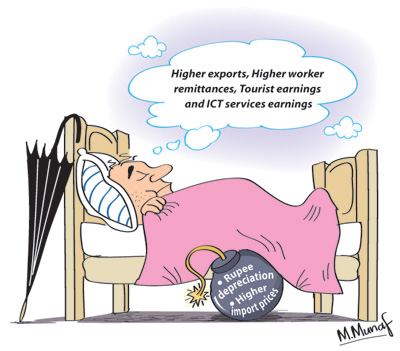Columns
Can we improve our external finances this year?
View(s):Everyone knows that the external finances of the country are in dire straits. The depletion of foreign reserves has been owing to the large trade deficits coupled with lesser worker remittances. Capital outflows compounded the problem. The all important question is whether this year’s trade performance, earnings from tourism and ICT services and remittances would generate a balance of payments surplus.
 Three factors
Three factors
The fortunes of the country’s external finances are dependent on three factors: the trade balance, receipts from services and net capital flows. In 2015 the trade balance recorded a high deficit of US$ 8.4 billion, worker remittances were slightly lower than in the previous year at US$ 6.98 billion and capital flows were negative. Consequently, the balance of payments was in deficit by as much as US$ 1.49 billion.
The favourable factors in 2015 were an increase in earnings from tourism by nearly 23 per cent to nearly US$ 3 billion and possibly an increase in earnings from ICT services. Despite these favourable developments, they were unable to offset the deficits in the trade balance.
 Reversal in balance of payments
Reversal in balance of payments
This balance of payments performance in 2015 was in contrast to the balance of payments in the previous year when a surplus of US$ 1.37 billion was recorded, despite a large trade deficit of US$ 8.3 billion. This balance of payments surplus was possible due to worker remittances of US$ 7 billion and tourist earnings of US$ 2.4 billion that wiped away the trade deficit. Earnings from ICT services and net capital inflows resulted in a balance of payments surplus of nearly US$ 1.4 billion.
Whither this year
Will this year’s performance in the trade balance, remittances and earnings from tourism and ICT services generate a balance of payments surplus? Preliminary analysis suggests that in spite of an unfavourable external situation and some adverse factors in the country, these three determining factors may facilitate a balance of payments surplus this year.
Trade balance
The unfavourable trade performance was the main cause of the strain on the balance of payments last year. The massive trade deficit of US$ 8.4 billion even surpassed the large deficit of US$ 8.3 billion in 2014. The trade deficit would have to be reduced this year below US$ 8 billion to make a dent in the balance of payments. A deficit of around US$ 7.5 billion is a realistic objective that can be achieved by a correct mix of monetary and fiscal policies.
Policies
The crisis situation has already brought about corrective measures that could enable a much lesser trade deficit. The depreciation of the rupee, increased import tariffs and tighter credit are likely to reduce imports. The government must be ready to make mid course corrections that would bring down the trade deficit to around US$ 7 billion. This would enable a valuable balance of payments surplus.
Exports
What are the prospects of increasing exports and curtailing imports to achieve such a result? The prospect of increasing exports significantly this year is remote. Tea prices may firm up a little, but domestic production is likely to be lower owing to the disruption in cultivation caused by the fall in prices, neglect of tea due to irregular plucking and lower fertilizer use. The hot temperatures expected till midyear will also result in a dip in green leaf collection and rubber output.
A drastic increase in manufactured exports cannot be expected as global recovery is slow. One favourable prospect is an increase in fish exports, if the EU ban on our exports is lifted later this year. At best exports would be around US$ 11 billion, marginally higher than last year’s export earnings of US$ 10.5 billion.
Imports
With limited prospects for exports, a reduction in imports is crucial. Such an improvement could be expected if the government continues its monetary and fiscal policies. The depreciation of the rupee, increased taxation of imported goods and tighter credit are likely to decrease imports. The import performance in the latter months of last year, and the first two months of this year, indicates a dip in imports. It should be possible to maintain the import bill at around US$ 18.5 billion compared to the US$ 18.9 billion last year. The government must keep a tab on imports, especially government expenditure that has high import content.
Fuel imports
Fuel import expenditure may increase this year. Although low fuel prices are expected to continue, oil import volumes are likely to increase. This is owing to much higher thermal generation due to expected lower rainfall in the first part of the year. Hydroelectricity generation has fallen during the first three months from 34 percent to only 25 percent of electricity generation and likely to dip further with drought conditions. Therefore the import bill on intermediate imports may rise somewhat.
Despite clamours for the reduction of retail prices of petroleum products, these should not be decreased in consideration of the current state of external finances.
Trade deficit 2016
With projected exports at US$ 11 billion and imports at US$ 18.5, the deficit would still be high at US$ 7.5 billion. Therefore imports should be brought down to US$ 18 billion so that the trade deficit is contained at US$ 7 billion that should achieve a balance of payments surplus.
Worker remittances that have been declining in December are not likely to increase from last year’s US$ 6.98 billion. In fact they are likely to decrease somewhat to around US$ 6.5 billion. On the other hand, earnings from tourism could be expected to increase to about US$ 3.4 billion from last year’s US$ 2.8 billion. These two items would wipe out a trade deficit of US$ 7 billion or even one of US$ 8 billion. A balance of payments surplus of more than US$ 2 billion could then be expected.
Bottom line
If the trade deficit could be contained at US$ 7 billion, earnings from tourism and ICT services could generate a healthy balance of payments surplus of over US$ 2.5 billion. It is imperative for the government to ensure that the trade deficit is contained to bring the external finances to an even keel.


Leave a Reply
Post Comment